Exercises for Early Ages - Fun exercises for preteens
The following exercises, adapted from Pat Stewart's U.S. Fitness Book , comprise a simple, easy-to-learn method of introducing a preteen child to a fitness program. The exercises have been designed for children six years old and older. Adult participation or supervision is appropriate if the young exercisers are six to ten years old. For those older than ten, supervision should not be necessary.
1. The wheelbarrow: Performed with two children, develops arm, shoulder, and abdominal strength. One participant kneels on the floor and places his hands down flat, directly under the shoulders. The fingers should point forward. The other child grasps the kneeling child's ankles and raises the legs. The first child “walks” forward on his hands while the partner keeps his feet suspended in the air at waist height. The walker should travel only three or four feet at the beginning.
2. The tortoise and hare: An aerobic exercise, the participants stand at attention. On the count of 1, the youngsters start to jog slowly in place. On the count of 2, the command “Hare” is given and the children double the tempo, lifting their knees high while their arms pump vigorously. On the count of 3, the command “Tortoise” brings the tempo back to an easy jog. The commands can be repeated every minute for four minutes.
3. Trees in the wind: Helps to develop trunk flexibility. The children stand in a circle, arms extended overhead. As the children run slowly in a circle, they bend left, forward, and right, then forward and back like trees swaying in a wind. The exercise can be continued for three or four minutes.
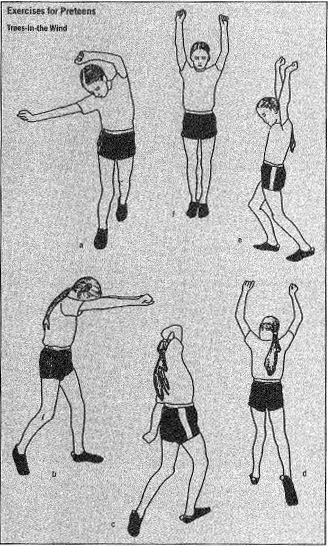
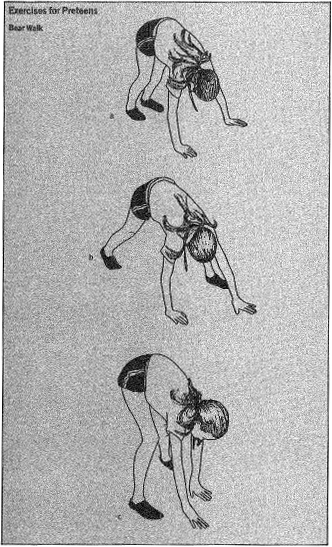
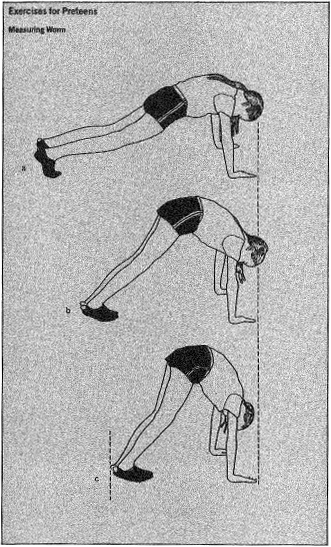
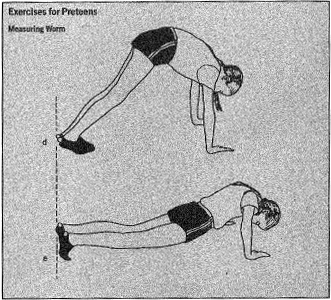
4. The gorilla walk: For flexibility and coordination, begins with the children standing and spreading their feet to shoulder width. They then bend at the waist and grasp their ankles. The knees should be kept straight. The participants walk forward while holding their ankles. A walk of three or four feet should be a good starting distance.
5. The hop: A leg-muscle builder, starts with the child standing straight. The child hops forward on the left foot only, taking long steps. Then he repeats on the right foot. A forward trip of three or four feet on each foot is enough.
6. The bear walk: For leg flexibility requires that the child bend forward from the waist. He places his hands on the floor, Moving around in a circle, the child moves his right arm and right leg at the same time as one step. Then he moves the left arm and left leg. Four circles will do.
7. The rabbit race: Another exercise for two or more children, the rabbit race promotes circulorespiratory fitness. The participants line up exactly as if they were taking part in a foot race; but they stand three feet apart, side by side, facing a marked finish line 60 feet away. The children race by hopping. They hold their feet together over the entire course, hopping with their toes pointed first toward the left, then toward the right, then straight ahead. They repeat these movements until they reach the finish line. Variations may be introduced. The children may hop on one leg, for example.
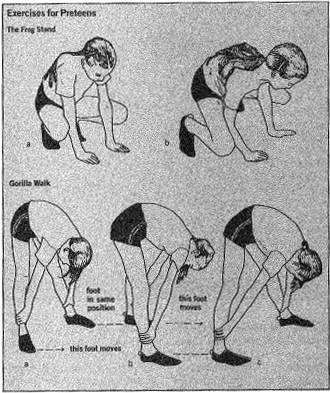
8. The frog stand: Strengthens the arms and enhances balance. The participant squats and places his hands on the floor. The fingers point forward and the elbows press against the inside of the knees. Leaning forward slowly, the child transfers his weight to his hands, going up on his toes and, if possible, raising his toes off the floor. He balances on his hands, keeping his head up. After several seconds in that position, he returns to the starting position. In repetitions the child tries to maintain his balance for increasingly longer periods.
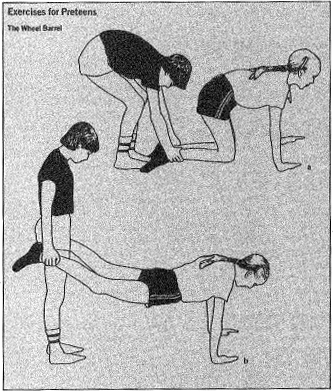
9. The coffee grinder: An upper-body strength builder, the coffee grinder requires that the child support his extended body on the right hand and his feet. The body is kept straight. The right arm and both legs are fully extended. The feet are slightly apart. In that position, the child “walks” his feet in a circle around the right arm, which serves as a pivot. The exercise should be repeated with the left arm supporting the body weight.
10. The measuring worm: Has been found effective in the development of strength in the lower back and hamstrings. The child assumes the push-up position with both hands on the floor and arms straight. Holding his hands in one place, the child “walks” his feet toward his hands. His back arches up. When he has walked his feet forward as far as possible, the child walks his hands forward by slow stages until he has assumed the original push-up position. Both walking actions should be repeated five times.
Two other exercises for children may be used or omitted depending on the child's strength, coordination, and flexibility. Both present a significant hazard of overextension of the knee muscles. Also, in the second exercise, a soft mat may have to be used for the child to kneel on to prevent bruises.
11. The bunny hop: Requires that the child assume a full squat position. His hands are placed alongside his head behind his ears, palms forward, to represent rabbit ears. The child hops in a circle with both feet together. Completing each hop, he lands again in the squat position. The hopping continues for two minutes.
12. The knee down: In the knee down, the child stands with the toes of both feet on a line. The child drops to both knees without taking his hands from his sides or moving his toes from the line. Then he returns to the standing position, again without using his hands or other aids. Five repetitions are prescribed.

Thank You somuch!